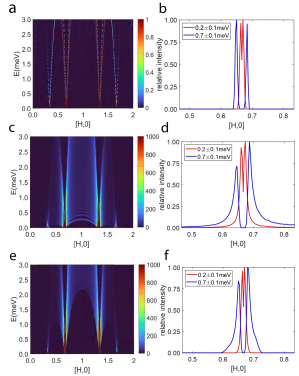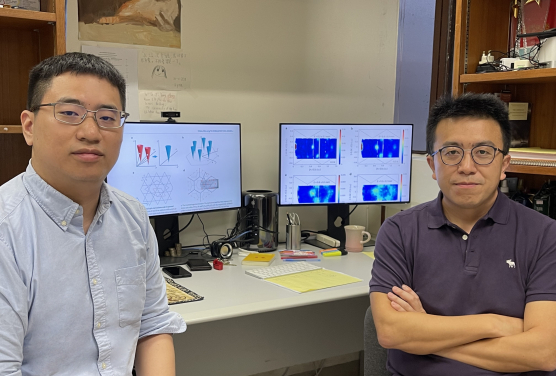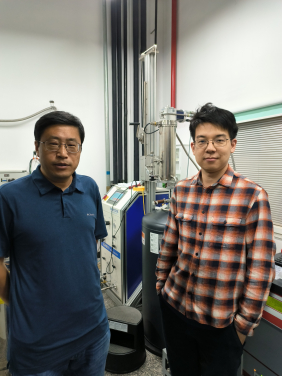Media
HKU Theoretical Physicists Collaborate alongside CAS Experimentalists Uncovering Novel Quantum State known as “Dirac Spin Liquid”
13 May 2024

Linear spin wave prediction on the kagome lattice: a and b show the spin spectra without introducing disorder effects. c and d display the spectra with the same parameters but introduce disordered effects to fit the experimental results. e and f show the spectra with different kinds of disorder.

Dr Chengkang Zhou (left) and Professor Zi Yang Meng (right) from the Department of Physics at The University of Hong Kong.

Professor Shiliang Li (left) and Mr Zhenyuan Zeng (right) from the Institute of Physics, Chinese Academy of Sciences.
![a. Schematic diagram of the conical excitations of Dirac spinons and the conical continuum spectrum formed by two spinons.
b. Schematic diagram of the conical spin excitations in YCu3(OH)6Br2[Br0.33(OD)0.67].
c. Relationship between the half-width at half-maximum and energy. The solid line represents a linear fit.
d. A magnified image of some co-aligned crystals, and the front view of co-aligned samples on two Cu plates.](/f/news/27305/826p376/Fig.2_page-0001.jpg)
a. Schematic diagram of the conical excitations of Dirac spinons and the conical continuum spectrum formed by two spinons.
b. Schematic diagram of the conical spin excitations in YCu3(OH)6Br2[Br0.33(OD)0.67].
c. Relationship between the half-width at half-maximum and energy. The solid line represents a linear fit.
d. A magnified image of some co-aligned crystals, and the front view of co-aligned samples on two Cu plates.
![Spin excitations in YCu3(OD)6[Br0.33(OD)0.67] measured via the neutron scattering. e,f, Intensity contour plots of the INS results as a function of E and Q along the [H, 0] direction at 0.3 K (e) and 30 K (f).](/f/news/27305/826p376/Fig.3_page-0001.jpg)
Spin excitations in YCu3(OD)6[Br0.33(OD)0.67] measured via the neutron scattering. e,f, Intensity contour plots of the INS results as a function of E and Q along the [H, 0] direction at 0.3 K (e) and 30 K (f).
- 1 / 5
- 2 / 5
- 3 / 5
- 4 / 5
- 5 / 5
A collaboration between theoretical physicists Dr Chengkang ZHOU and Professor Zi Yang MENG from the Department of Physics at The University of Hong Kong (HKU), along with experimentalists Zhenyuan ZENG and Professor Shiliang LI at the Institute of Physics (IOP), Chinese Academy of Sciences (CAS), and Professor Kenji NAKAJIMA from J-PARC Center, Japan, has led to a discovery in the realm of quantum physics. Their study, published in a recent issue of Nature Physics, sheds light on the long-anticipated emergence of quasiparticles, akin to the famous Dirac particles obeying the relativistic Dirac equation. These quasiparticles, known as Dirac spinons, were theorised to exist within a novel quantum state called a quantum spin liquid state.
Quasiparticles are intriguing entities that emerge from collective behaviour within materials, which can be treated like a group of particles. The Dirac spinons, specifically, are expected to exhibit unique characteristics similar to Dirac particles in high-energy physics and the Dirac electrons in graphene and quantum moire materials, such as a linear dispersion relation between energy and momentum. But such spin-½ charge neutral quasiparticles have not been seen in quantum magnets till this work.
‘“To find Dirac spinons in quantum magnets has been the dream of generations of condensed matter physicists; now that we have seen the evidence of them, one can start to think about the countless potential applications of such highly entangled quantum material. Who knows, maybe one day people will build quantum computers with it, just as people have been doing in the past half-century with silicon,’” said Professor Meng, HKU physicist and one of the corresponding authors of the paper.
The team's investigation focused on a unique material known as YCu3-Br, characterised by a kagome lattice structure leading to the appearance of these elusive quasiparticles. Previous studies had hinted at the material's potential to exhibit a quantum spin liquid state, making it an ideal candidate for exploration. In order to enable the observation of spinons in YCu3-Br, the research team overcame numerous challenges by assembling approximately 5000 single crystals together, meeting the requirements for conducting experiments such as inelastic neutron scattering (see Fig. 1d). Using advanced techniques like inelastic neutron scattering, the team probed the material's spin excitations and observed intriguing conical spin continuum patterns, reminiscent of the characteristic Dirac cone. While directly detecting single spinon proved challenging due to experimental limitations, the team compared their findings with theoretical predictions, revealing distinct spectral features indicative of the presence of spinons in the material.
Finding spectral evidence of Dirac spinon excitations has always been a challenge. This discovery provides compelling evidence for the existence of a Dirac quantum spin liquid state, which can be akin to a clear cry cutting through the fog of spectral investigation on the quantum spin liquid state. The findings not only advance our fundamental understanding of condensed matter physics but also open doors for further exploration into the properties and applications of YCu3-Br.
Characterised by the presence of fractional spinon excitations, the quantum spin liquid state is potentially relevant to high-temperature superconductivity and quantum information. In this state, the spins are highly entangled and remain disordered even at low temperatures. Therefore, investigating the spectral signals arising from spinons obeying the Dirac equation would provide a broader understanding of the quantum spin liquid state of matter. Such understanding also serves as a guidepost toward its broader applications, including the exploration of high-temperature superconductivity and quantum information.
For a detailed explanation of the research, please visit here: https://www.scifac.hku.hk/page/detail/8595
The journal paper entitled ‘Spectral evidence for Dirac spinons in a kagome lattice antiferromagnet’ can be accessed from here: https://www.nature.com/articles/s41567-024-02495-z
The study was supported by the Ministry of Science and Technology of China, the Chinese Academy of Sciences and grants from Hong Kong Research Grants Council. Neutron scattering measurements were performed on AMATERAS, J-PARC.
The theoretical work of the paper is carried out by Dr Chengkang Zhou, a Postdoctoral Fellow at the Department of Physics, and his supervisor, Professor Zi Yang MENG. They are supported by the Collaborative Research Fund and ANR/RGC Joint Research Scheme of the Hong Kong Research Grants Council, highlighting the forward-looking perspective and support of the Hong Kong government in the research of quantum materials. The theoretical calculations conducted in this study were performed on the High-Performance Computing Platform at the Information Technology Services, HKU, and the ‘Blackbody’ supercomputer at the Department of Physics at HKU, as well as the Beijing PARATERA Tech CO., Ltd. (https://cloud.paratera.com).
For media enquiries, please contact Ms Casey To, External Relations Officer (Tel: 3917 4948; Email: caseyto@hku.hk)/Ms Cindy Chan, Assistant Director of Communications of HKU Faculty of Science (Tel: 39175286; Email: cindycst@hku.hk).
